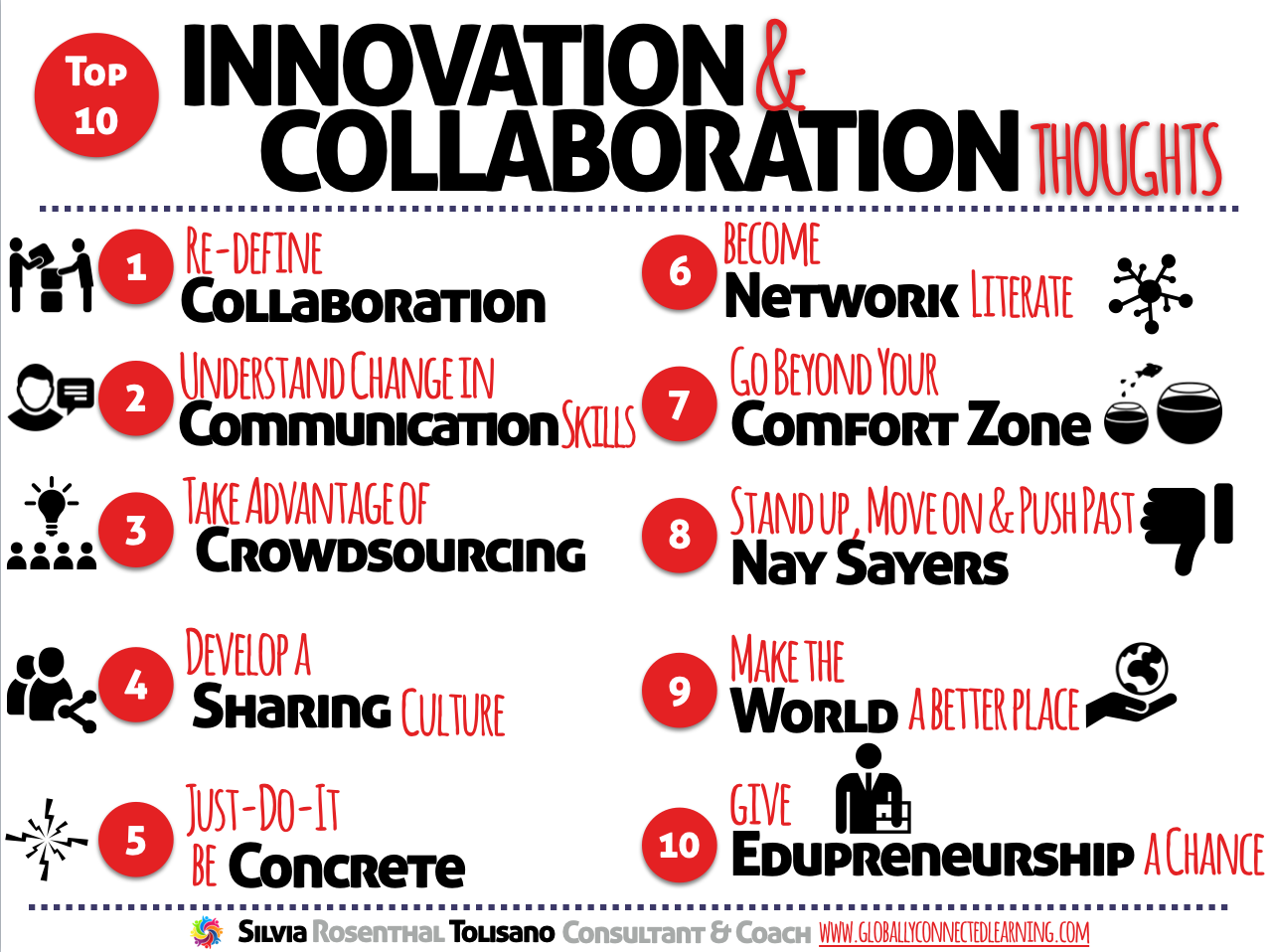Top 10 Innovation & Collaboration Thoughts

A buzzword is a word, that is frequently used and fashionable at a particular time or in a particular context. Currently, innovation seems to be such word in the educational arena.
I am trying to wrap my mind around what Innovation actually is and means for education. In German, there is a saying “Ich muss mich mal schlau darüber machen”- I have to make myself smart on that topic (literal translation) and figure out the angle, that I want to pursue delve deeper into innovation.
I have seen too many examples of innovation around me, that just didn’t seem, well, innovative. I remember schools racing to be able to tell and show their stakeholders they were innovative and on the cutting edge of technology when they installed SmartBoards in all their classrooms. Unfortunately, I also remember that most of these “innovative devices” were not used beyond substituting a worksheet on a piece of paper or as a projector screen. What about the “innovative iPads” in schools or some of the maker spaces and 1 hour-a-year coding classes? Most don’t seem too innovative to me.
So I am paying attention to the posts and tweets about Innovation on my social media network, I chose a few books to read (paper and ebooks) and TED Talks to watch. Now, I am trying to make sense of the perspectives of these authors and speakers. Here are some quotes, notes and thoughts around Innovation that stood out for me.
I started out watching Guy Kawasaki in a TED Talk, where he shares a Top Ten list of the The Art of Innovation in order to change the world.
1. Make Meaning in order to change the world (not making money)
2. Make a Mantra, why you should exist (not a mission statement)
3. Matter of perspective, jump curves. (Don’t define yourself with what you do, but what benefits you provide)
4. Roll the Dicee (deep, intelligent, complete, empowering, elegant)
5. Don’t worry, be crappy (don’t wait to the perfect world, ship things that take your best might have an element of imperfection)
6. Let a hundred flowers blossom (You might know what you want your brand to stand for, but your consumers will ultimately decide)
7. Polarize people
8. Churn, Baby Churn (make version 1, then 1.1, then 1.2….1.9, then 2.0. Ignore people who tell you it can’t be done. keep changing and evolving your product
9. Niche thyself (uniqueness and value)
10. Perfect your Pitch (customize your introduction)
Kim Bhasin in the Business Insider shares the following definition of Innovation (in comparison with Invention)
Tech & Learning Newsletter
Tools and ideas to transform education. Sign up below.
Innovation happens when someone “improves on or makes a significant contribution” to something that has already been invented.
Don Wettrick in his book Pure Genius: Building a Culture of Innovation and Taking 20% Time to the Next Level
Innovation brings new solutions to problems that arise in a changing environment.
George Couros in The Innovator’s Mindset: Empower Learning, Unleash Talent, and Lead a Culture of Creativitydefines Innovation
as a way of thinking that creates something new and better. Innovation can come from either “invention” (something totally new) or “iteration” ,a change of something that already exists), but if it does not meet the idea of “new” and better”, it is not innovative.
Innovation and Collaboration
The three quotes above from Bhasin, Wettrick and Couros, from their respective books, made sense as an overall definition of innovation, but it was Issacson’s connection to collaboration that “sealed the deal” for me. Collaboration has always existed, but how we can take advantage of the power of technology and the Internet, that we can truly collaborate in “new and better” ways … and that changes everything… that is what can make it transformative. It is about taking collaboration beyond working in groups in our classrooms, teams, subject areas or school silos. It is about using the technology at our disposal to connect, collaborate and learn in order to change the world.
Walter Isaacson in The Innovators: How a Group of Hackers, Geniuses, and Geeks Created the Digital Revolution stresses that when innovators collaborate and with the “ability to work as a team, made them even more creative. […] It’s when innovators turn disruptive ideas into realities“.
Digging deeper into the other books, it is collaboration that I see emerging as a common thread .
Couros’ makes being networked part of his eight characteristics of an innovator’s mindset. He uses the word “crucial” to emphasize its importance.
Innovation (and enjoyment) flourishes when teachers collaborate to learn and practice new strategies. Isolation is often the enemy of innovation.
Wettrick, dedicates an entire chapter to collaboration with experts from around the world and helping his students amplify their message via social media. He calls “Collaboration: The Name of the New Game” and at “the heart of why we need an Innovation Class model”. Wettrick shares Six Building Blocks of Innovative Learning. Collaboration is the first building block on his list- ” Look farther than the person beside you”.
Collaboration should include networking with real-world experts, as well as other students.
Isaacson also concludes
that innovation is usually a group effort, involving collaboration between visionaries and engineers, and that creativity comes from drawing on many sources.
but he calls the following revolutionary
The Internet facilitated collaboration not only within teams, but also among crowds of people who didn’t know each other. This is the advance that is closest to being revolutionary. Networks for collaboration have existed since the Persians an Assyrians invented postal systems. But never before has it been easily to solicit and collate contributions from thousands or millions of unknown collaborators.
So, what does all of this mean in terms of for schools, administrators, teachers and students?
Here are my Top 10 Innovation & Collaboration Thoughts. Where do we start? What skills need to be in place? How do we move a collaborative and innovative reality in our schools forward?

- Re-define Collaboration
Redefine what “collaboration” means in today’s world. Taking all the technological advancements into consideration and being aware of their constantly evolving capabilities, are we taking advantage of the transformative possibilities of collaborating globally, asynchronously and exponential connections? How do we make sure we are not talking at cross purposes with each other and our stakeholders about what collaboration signifies in the second decade of the 21st century? - Understand the Change in Communication Skills
The skill to communicate is basic, but at the same time, has changed drastically and exponentially. Being able to read and write on an analog platform, is no longer the only relevant platform and is fast becoming the least relevant form of communicating in every day life. Schools, curriculum plans, articulated learning skills need to reflect that change. Being capable to communicate through a variety of multimedia and platforms is more important than ever to share and collaborate beyond our local comfort zone, specific audiences, across time zones, geographic boundaries, cultures and languages. - Take Advantage of Crowdsourcing
Let’s embed crowdsourcing opportunities as an integral part of our learning process. How do we learn the skills to solicit, connect, collect, evaluate, learn from different global perspectives and create something “new and better” out of the contributions from people we don’t even know? - Develop A Sharing Culture
In order to collaborate, there has to be a culture of sharing in place. No collaboration is possible, if no one is willing or capable of sharing. How do we nurture the disposition of a sharing culture in our schools and learners? How do we encourage this sharing disposition in order to foster collaboration and innovation when it collides with competitiveness that might be otherwise (consciously or unconsciously) present? The term sharing also needs to be re-defined in order to include the openly and transparent sharing on a global forum such as social media platforms, blogs, websites and wikis. - Just do it- Be Concrete
Find concrete ways to amplify (beyond the person next to you) collaboration for learners. Let’s not talk about the big picture of what needs to happen in order to be innovative. Let’s design, prototype, fail and be continuously in a beta version. These opportunities can’t only focus on amplify for student learning, but need to include educators and administrators as learners, collaborators and innovators. - Become Network Literate
To be able to connect with experts and peers from around the world in order to collaborate, we need to have the skills to understand, value, create, maintain and grow a network. Network literacy includes the understanding of network intelligence and the ability to take advantage of different network platforms and capabilities. Becoming network literate is as important for administrators as it is for educators and students. This puts everyone on the same playing field to connect and collaborate. - Go Beyond Your Comfort Zone
We know that very little or no learning occurs in our so called comfort zone. It is imperative to push ourselves or allow others to push us outside of that zone in order to enter a learning zone . This applies also to pushing ourselves out of our field of expertise and learn to connect Information from different fields. Innovation is when we use something and Remember what happens to companies, like Blockbuster or Kodak, who were too comfortable in their zone to catch the warning signs of change to their “expertise”. - Stand Up, Move On and Push Past Nay Sayers
Develop a thicker skin to be able to withstand the powers who are against change, always find a reason why this or that won’t work or not capable of seeing success past a beta version. Innovators become leaders who model for others, support and promote their first followers and scale this support by enabling their first followers to become leaders. - Make the World a Better Place
One purpose of learning is /should be making the world a better place. Let’s embed that principal in our reflective and metacognitive practices. How can we take what we know and then make something new and better out of it? How can we add more “what action will you take”? to our instructional designing and curriculum planning? How can collaboration add value by adding perspectives (desperately needed in order to not just make it a better place for a specific group of people) from around the world ? - Give Edupreneurship a Chance
Edupreneurship is the educational methodology based on innovation and entrepreneurship. How can we embed this methodology to teach/learn real world skills? Let’s give learners authentic opportunities to be exposed to non-simulated experiences, receive authentic feedback and assessment. Let’s all become action researchers to better the field of education or in our area of passion. Let’s not just do projects in or for our schools that are confined to a simulated environment, but serve a real world audience.
cross posted at langwitches.org/blog
Silvia Tolisano is a Curriculum21 faculty member, author of the book Digital Storytelling Tools for Educators and founder of the Around the World with 80 Schools project. Read more at http://langwitches.org/blog.
